
Abandoned & Little-Known Airfields:
Northwestern New Jersey
© 2002, © 2016 by Paul Freeman. Revised 1/9/16.
This site covers airfields in all 50 states: Click here for the site's main menu.
____________________________________________________
Please consider a financial contribution to support the continued growth & operation of this site.
Aircraft Radio Corporation Airfield (revised 6/14/14) - Budd Lake Airfield (revised 8/3/15) - Flanders Valley Airport (revised 4/18/15) - Newton Airport (revised 1/9/16)
____________________________________________________
Newton Airport (3N5), Newton, NJ
41.025, -74.76 (Northwest of New York, NY)

Newton Airport, as depicted on the 1965 NY Sectional Chart.
Yet another one of the amazingly disproportionate number of general aviation airports which have been lost to “redevelopment” in NJ.
Why has NJ lost so many small airports?
Does the NJ state government & aviation organizations not care about NJ's disappearing general aviation infrastructure?
Newton Airport was not yet depicted on the 1958 NY Sectional Chart.
The date of construction of Newton Airport has not been determined.
The earliest reference which has been located of Newton Airport came from Richard Halstead,
who reported, “Newton Airport... The logbook of my grandfather [Lyle Halstead] shows he landed there in June, 1961 in the company Aero Commander 680.
Since I see no other flights in his records in the general timeframe from unimproved runways, my hunch it that Newton was probably paved by that date.”
According to its FAA Airport/Facility Directory data, Newton Airport was established in April 1962.
The earliest depiction which has been located of Newton Airport was on the 1965 NY Sectional Chart.
It depicted Newton as having a 2,000' unpaved runway.

The earliest photo which has been located of Newton Airport was a 2/24/70 USGS aerial view.
It depicted Newton as having a paved northeast/southwest runway,
and an unpaved crosswind Runway 11/29 (labeled with runway numbers, somewhat unusual for a grass runway).
A total of at least 9 light aircraft were visible on the north side of the paved runway.

Newton evidently gained a paved runway at some point between 1965-71,
as the 1971 USGS topo map depicted a single paved northeast/southwest runway, labeled simply as “Landing Strip”,
along with several small buildings on the east side.

A 4/4/94 USGS aerial view looking southwest depicted Newton as having a paved northeast/southwest runway, and an unpaved crosswind runway.
A total of at least 6 light aircraft were visible on the northeast & southeast sides of the paved runway.

A 2000-2003 photo by Chris Uminowicz of skydivers loading onboard a CASA 212 at Newton Airport.

A 2000-2003 photo by Chris Uminowicz of a skydiving Cessna Caravan taking off from Newton Airport.

A 2000-2003 photo by Chris Uminowicz of a skydiving de Havilland Twin Otter landing at Newton Airport.

A 2000-2003 photo by Chris Uminowicz of Newton Airport's paved runway.
Chris Uminowicz recalled, “Newton Airport... the locals shut the dropzone down.
I was surprised at that since the airport owners took money from the FAA to repave the runway.
There was a town meeting, and the zoning commission said no jet aircraft, and they considered a 'turboprop' to be a jet.”

An 8/6/06 photo looking northeast at Newton's runway, & hangar, showing one aircraft inside the hangar, and a windsock.

An 8/6/06 photo showing one aircraft inside Newton's hangar.

An 8/6/06 photo of an ultralight which has seen better days in front of a shed at Newton Airport.
According to its FAA Airport/Facility Directory data, in 2009 Newton Airport was described as having conducted an average of 29 takeoffs or landings per day.
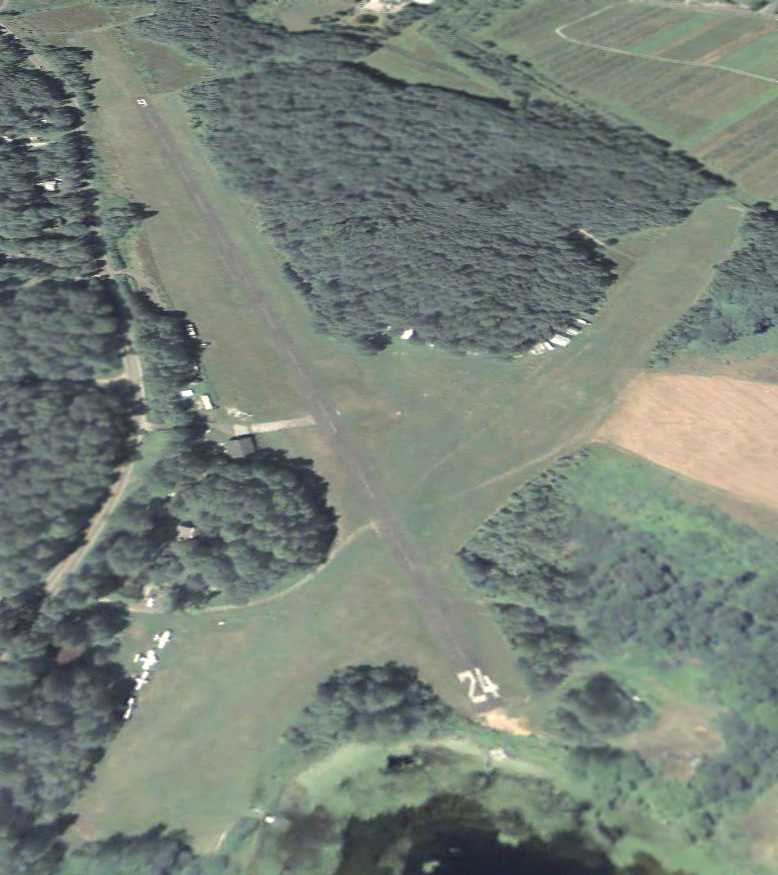
A 2010 aerial view looking southwest along Newton's Runway 24 showed 4 light aircraft visible on the field.

The 2012 NY Terminal Area Chart depicted Newton as having a single paved 2,500' runway.
As of 2013, Newton Airport's FAA Airport/Facility Directory data described the field as having a single 2,546' asphalt Runway 6/24.
The owner was listed as RRL group, and the manager listed as Tony Valente.
Newton was said to have 18 aircraft based on the field, including 1 helicopter & 10 ultralights.

The last photo which has been located showing aircraft at Newton Airport was a January 2013 photo of a Cessna 150 or 152 on a snow-covered field.
In January 2013, it was announced that Newton Airport would be closing,
as it had been purchased by a utility company which planned to use the property to stage electrical power equipment used in constructing new transmission lines.
How many small airports does NJ have to lose? When does it stop?
An article entitled “Up, up, and away” by By Jessica Reyes in the 1/12/13 NJ Herald (courtesy of Mark Krefting) noted,
“Local aviation enthusiasts say that the recent sale of Newton Airport to Public Service Electric & Gas highlights the national trend of small airports shutting down.
The number of public use and general aviation airports in NJ has dropped from 82 in 1950 to 44 today, according to the state Department of Transportation.
The sale of Newton Airport makes it the latest airport to close, leaving Sussex County with 3 airports:
Trinca in Green, Aeroflex-Andover in Andover & Sussex Airport in Wantage - according to the state.”
Barry Landy, a Chief Flight Instructor at the Essex County Airport in Caldwell, has seen this trend firsthand.
"I've been in this business for 42 years, and I've seen about 42 airports, just in New Jersey, close," Landy said.
The article continued, “PSE&G, a power company that supplies nearly three-quarters of NJ residents, bought the Newton Airport in December
for $3.5 million to use for the storage & construction of pieces of the new 500,000-volt transmission line
that is planned to run from Susquehanna in PA to Roseland in Essex County.
Cynthia DeCristofaro, a broker associate with Weichert Realtors Sparta, was the selling agent for this sale,
which is one of the largest recorded sales in Sussex County in several years.
Since the Susquehanna-Roseland transmission line will run through 6 Sussex County municipalities,
George Sous, Manager of Transmission Outreach, said the 96-acre Newton Airport is an ideal location for storing steel & other hardware
that will be used to construct 200-foot-tall towers that will replace existing 90-foot towers built in the 1920s.
Helicopters will move the partially assembled towers from the airport to environmentally sensitive areas & locations that are challenging to access.
Local pilots hope that when this project is complete in 2015, PSE&G would consider returning the property to a public-use airport.
Sous said PSE&G has not decided that yet.”
"There is no plan for what we are going to do once we are done with the construction," Sous said, adding that PSE&G is "focusing on the task at hand."
He said pilots or others with questions about the project could contact a hotline at 888-771-7734.
The article continued, “Users of the airport & neighbors said it received little traffic in recent years.
Joshua Weinstein, a Green resident & instructor at Essex County Airport,
said over the years he & Landy have used the Newton Airport for emergency training & simple landings for students.”
"It's a nice long runway for our purposes, and it's generally pretty well maintained," Landy said.
The article continued, “They will now have to find an alternate airport for training,
which may be difficult considering Aeroflex-Andover has a shorter runway & is often busy on weekends,
while Trinca has a grass strip that is not ideal for that purpose.”
"Newton is an important place, but its not heavily utilized," Weinstein said. "(The issue is) when these close, they do not come back."
Weinstein said he used Newton Airport often, but recently only saw smaller ultralight aircraft stored there.
The airport had an asphalt runway, but did not provide fuel services or lights for night operation.
"It will be sorely missed, and I'm really hopeful that PSE&G returns it to an airport status when they are finished with it," Weinstein said.
The article continued, “Pecoraro said that it is not uncommon to hear of privately owned, public-use airports closing,
mainly due to the financial gains or business decisions that can come from selling the land for other purposes.
He said NJ has significantly more privately owned, public-use airports than other states, and therefore may be seeing a higher number of closures.”
"We, of course, as an organization that represents individual pilots and owners, are interested to see them stay open," Pecoraro said.
The article continued, “Weinstein said sometimes private airports are sold for the land.”
"They can sell off 100 acres of airport land and turn it into 200 condos, and that makes a lot of financial sense in the near-term to pull in all that money,
but there have been instances where residents have wanted to get rid of the airport (for another use),
but then they realize it increases traffic & the strain (on the area)," Weinstein said.
Weinstein said the public sometimes does not realize "all the hidden benefits" to having an airport in the community.
These airports not only serve pilots, but also help with aerial firefighting, law enforcement, search-and-rescue operations, and airlifts to hospitals.
"People tend to forget about all that," Weinstein said.
The article continued, “Landy said airports also hire local residents for jobs, draw people to the area and aid local businesses.
Also, the pilots who use small airports often go on to be pilots working for airlines and for the military.”
"They all don't have to be LaGuardia or Newark or Kennedy; the smaller airports are aiding the local businesses," Landy said.
"There is tremendous long-term economic benefit to having a local airport."
The article continued, “There is sometimes a perception that living near an airport is noisy and disturbing,
but Weinstein said these small airports are not like being near major airports like Newark Liberty International Airport.”
"A lot of people think of (airports) as nuisances, but it is a lot more than that," Kiss said. " It has a lot of value that people don't see right away."
Newton Airport is located north of the intersection of Stickles Pond Road & Bernard Drive.
____________________________________________________
Budd Lake Airfield, Budd Lake, NJ
40.84, -74.775 (West of New York, NY)

Budd Lake Airport, as depicted on the 1950 NY Sectional Chart (courtesy of Mike Keefe).
Budd Lake Airfield was apparently opened at some point between 1945-49,
as it was not depicted at all on the 1943 USGS topo map nor on the 1945 NY Sectional Chart nor on the 1947 USGS topo map.
The earliest depiction of the airfield which has been located
was on the 1949 NY Sectional Chart (according to Chris Kennedy).
According to Bob Zimmerman (who grew up across the road from Budd Lake Airport),
"The airport began business shortly after WW2.
The property owner's son wanted a place close to home where he could learn to fly & keep his airplane.
They dedicated about 90 acres of their farm & leased the property to Howard Bartholomew - the FBO.
He offered lessons, tie downs hangars, fuel, repairs & a snack bar.
The 'admin' building was a 2 story cinderblock building which still stands, but is obscured by overgrowth.
There was a row of tin-roofed open-front hangars that could accommodate approximately 20 planes.
A concrete fuel island is still in place in front of the building."

The earliest photo which has been located of Budd Lake Airfield was a circa 1950-54 aerial view (courtesy of Tom Beamer).
It depicted the field as having 2 grass runways,
and a row of 10 T-hangars along the southwest side, in front of which was seen one light aircraft.

A circa 1950-54 photo of the "Control Tower" at Budd Lake (courtesy of Tom Beamer).

A circa 1950-54 photo of hand-propping a Civil Air Patrol Cub at Budd Lake (courtesy of Tom Beamer).
According to J. Passannante, "I believe the man propping the cub is my father (though hard to tell)."
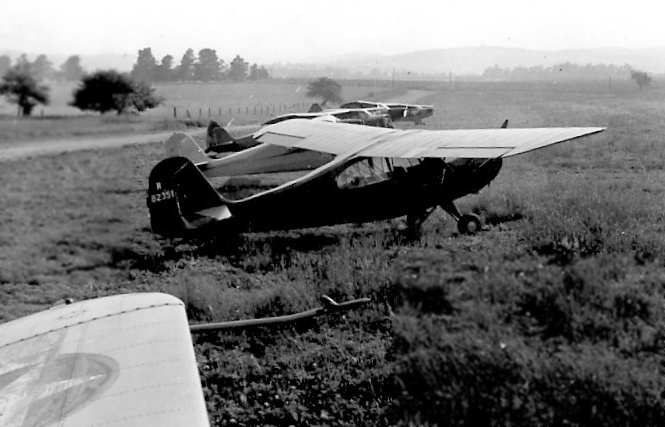
A circa 1950-54 photo of planes parked at Budd Lake (courtesy of Tom Beamer).

A circa 1950-54 photo of "Bart" Howard Bartholomew at Budd Lake (courtesy of Tom Beamer).
According to Tom Beamer, Budd Lake was operated by "Bart", Howard Bartholomew.
The runway at Budd Lake Airport was "1,800' long with wires at one end & trees at the other.
They operated T-6s, BT-13s, the typical assorted light planes of the era & the Stinson Reliant.
It was a different era - accidents were expected."
Tom continued, "There was a very active CAP [Civil Air Patrol] Squadron there.
In the [aerial photo above] you can see the buildings in the lower left.
Bart built a small square office & some T-hangars, rather basic.
He was a GREAT guy, learned to fly at Mitchel Field in a Hisso Jenny in 1920,
knew the business well, filled with charisma,
unfortunately he made the mistake of building his businesses on rented airports."

An undated photo of John Lewis in the back seat of Piper J-3 Cub N98138 at Budd Lake, with "Bart" Howard Bartholomew in the front seat (courtesy of John Lewis).
John Lewis recalled, “I took my training through to a private license with Bart & Bill Rhode who was also did parachute testing for Switlik & wrote 4 books on early aviation.”

An undated business card of Budd Lake Airport's Bart's Flying Service (courtesy of John Lewis).

The 1953 USGS topo map depicted Budd Lake Airfield as an open field with 2 small buildings.
According to J. Passannante, "My father was based at Budd Lake.
The BT-13 mentioned at Budd Lake was my father's.
Two more planes he kept there were a 1946 85 hp Swift, an AT-6,
a Ryan PT-22, military & civilian versions."
According to Bob Zimmerman, "The airport ceased operations in 1956 or 57.
The FBO moved to Princeton & leased Princeton Airport until the mid 1960's."
[Operator Bart Bartholomew also later operated Skyport Airport in PA.]
In a 1996 report by the New Jersey General Aviation Study Commission's Subcommittee on Airport Closings,
reasons were given for the closing of 13 New Jersey general aviation airports.
According to the report, Budd Lake Airport closed because the owner (who lived about 500 feet from the runway)
did not like the noise & refused to renew the lease.
Budd Lake was definitely closed prior to 1957,
as it was not depicted at all on the 1957 NY Sectional Chart (courtesy of Mike Keefe).
A 1957 aerial view depicted the airfield as basically intact (including all of the T-hangars),
but there were no aircraft visible on the field.
All but 2 of the T-hangars had been removed at some point between 1957-63, as seen in a 1963 aerial view.
The runways area remained clear, though.
Only a sole T-hangar remained standing by the time of a 1970 aerial photo (and a 1971 aerial photo).

Budd Lake Airfield was still depicted on the 1971 USGS topo map,
even though the field had been closed for at least 14 years by that point.
The 1986 USGS topo map still depicted Budd Lake Airfield,
with a single 2,100' runway, oriented northwest/southeast.
Eileen Stokes (of the Washington Township Historic Society) reported in 2003
that the former Budd Lake Airport "will soon be built upon for a new elementary school.
Several folks are looking to document the site & story for an eventual display in the school."
However a 2006 aerial view shows that the elementary school was built at some point between 2002-2006,
but adjacent to the southwest side of the Budd Lake Airport property,
and a 2007 aerial view shows that a single small building appeared to remain standing on the southwest side of the airport property.

A circa 2007-2010 aerial view looking south of all that remains from Budd Lake Airport -
a single small building on the southwest side of the airport property.

A 9/18/13 aerial photo shows the site of Budd Lake Airfield to remain an open field,
but without a trace that would be recognizable to an observer that is was once a vibrant little airport.
The site of Budd Lake Airport is located south of the intersection of Drakestown Road & Church Road.
Thanks to James G. for pointing out this airfield.
____________________________________________________
Flanders Valley Airport (81N), Flanders, NJ
40.838, -74.685 (West of New York, NY)

A 1963 aerial view depicted Flanders Valley Airport as having a single east/west grass runway visible.
The precise date of establishment of Flanders Valley Airport has not been determined.
It was not yet depicted on the 1947 USGS topo map.
A 1957 aerial view appeared to depict the beginnings of Flanders Valley Airport,
with cuts having been made in 2 treelines, making a clear path for what would eventually be the runway.
A 1963 aerial view depicted a single east/west grass runway.
There were no aircraft visible on the field.
Flanders Valley was not yet depicted on the March 1966 NY Sectional Chart (courtesy of Mike Keefe).

The earliest aeronautical chart depiction of Flanders Valley which has been located
was on the 1967 NY Local Aeronautical Chart (courtesy of Mike Keefe).
It described Flanders Valley as a private field having a single 2,500' turf runway.
Richard Krentz recalled, "I received my flight training from Frank Ragucci at that airport [in 1968]
and subsequently got my instrument rating there also.
In my minds eye I can relive my experiences & all the people there since 1968 when I first started to fly.
Those were 'good ole days'.
Flanders Valley was one of those airports where you always felt at home.
The hangar flying was the best in the country, and as I said, the pies were to die for.
I have many picture of the pilots & planes that were there
and the little restaurant there that served the best apple & berry pies in the world, a pilots dream."
The runway at Flanders Valley was evidently paved at some point between 1967-69,
as the 1969 NY Sectional Chart (according to Chris Kennedy)
described Flanders Valley as having a single 2,200' asphalt runway.

The 1970 USGS topo map depicted “Valley Airport” as having a single east/west paved runway,
a perpendicular taxiway, a small ramp, and several small buildings on the southwest side.
The 1971 NY Sectional Chart (according to Chris Kennedy) depicted "Flanders" as having a 2,200' runway.
The 1971 Flight Guide (according to Chris Kennedy)
depicted "Valley (Flanders)" as having a single 2,224' paved Runway 10/28.
Erika Eick recalled, "I was living in Flanders, NJ, in the seventies.
I rode in my 1st airplane in 1973 at Flanders Valley Airport.
It was in a Piper Cherokee 140 & a pilot named Roy flew my sister & I around Flanders.
My sister & I rode bicycles to the airport & found the rides were priced at $3 / person for twenty minutes.
We rode home to bug our father to take us there & let us fly.
I later took my grandmother & aunt from Holland there to take a flight in a 172.
We barely got off the ground on Runway 28 as the plane was heavy & it was summertime.
I used to love going there on weekends & watching cows & airplanes do their thing.
My experiences there led me to join the Army & go into avionics.
I will never forget those days!"
J. Passannante recalled, "I was based out of Hackettstown Airport in the 1970s,
and visited Flanders every Sunday afternoon, for many years.
The man who owned Flanders at the time was Walt Hoffman."
The 1975 NY Local Aeronautical Chart (courtesy of Mike Keefe)
depicted Flanders Valley Airport as having a 2,200' paved runway.
Flanders Valley Airport was still depicted as an active airfield on the 1979 NY TCA chart (courtesy of Bill Suffa).
It was depicted as having a single 2,200' paved east/west runway.

As was depicted on the 1981 USGS topo map, the airfield consisted of a single 2,300' paved runway,
a perpendicular taxiway, a small ramp & at least one hangar.
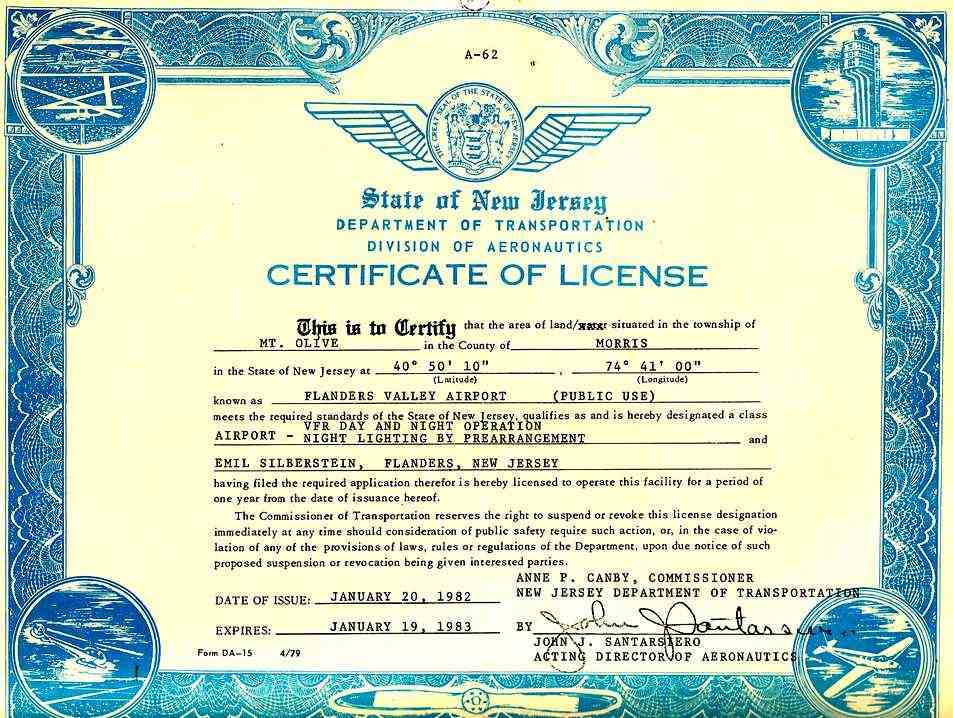
The NJ Department of Transportation 1982 License for Flanders Valley Airport.

The last aeronautical chart depiction which has been located of Flanders Valley Airport
was on the June 1982 NY Terminal Aeronautical Chart (courtesy of Mitchell Hymowitz).
It depicted Flanders Valley Airport as having a single 2,200' paved east/west runway.

The 1983 Flight Guide (courtesy of Chris Kennedy)
depicted Flanders Valley as having a single 2,224' paved Runway 10/28,
with a taxiway leading to a ramp with a single building (a hangar?) on the south side of the field.
The remarks said: "Runway 10 - closed for takeoff with less than 10 kt headwind."
Richard Krentz recalled, "My last flight from that airport… was 1984
and the airport was shut down shortly afterward."

A 1986 photo by Dick Krentz looking west at Flanders Valley Airport,
with over 40 light aircraft visible on the field.

A 1986 photo of Robert Bond (the last manager of the airport) & Al Montecalvo at the Flanders Valley Airport sign.
According to Michael Bond,, “Bond aviation was the FBO there, [which] provided flight training, aircraft maintenance/inspections, etc.
Flight Deck was a graphics artist, [which] did lots of signs.”

The last photo which has been located showing the Flanders Valley Airport while it was open was a 1987 aerial view.
The airport was obviously very well-used right up to the end,
as a total of over 40 aircraft were visible on the field.
According to Roger Hendrixson, “The AT&T Flying Club operated out of the Flanders Airport up to the mid-1990s.
The club had a Cessna 152 & 172.”
Richard Krentz recalled, "It was a sad day when I got the call that Flanders was closing forever.
We were sad to see the place go but the developer got his way as usual & that was that."
In a 1996 report by the New Jersey General Aviation Study Commission's Subcommittee on Airport Closings,
reasons were given for the closing of 13 New Jersey general aviation airports.
According to the report, Flanders Valley Airport closed when the developers encroached on the runway,
building homes very close to the approach end of one runway.

By the time of a 1995 USGS aerial photo, the eastern half of the airfield property had been redeveloped as a housing subdivision
(which ironically has streets named Wright Court, Lindbergh Drive & Earhart Drive).

A sad 1996 aerial view looking west at the remains of Flanders Valley by Philip Kineyko.
The hangar is at the left, while the remaining runway portion is at the right.
Flanders Valley Airport was no longer depicted at all (even as an abandoned airfield) on the 1998 World Aeronautical Chart.

As of a circa 2001 aerial photo, a 1,000' portion of the western end of the runway still existed, as well as the perpendicular taxiway,
and the ramp & hangar at the southern end of the taxiway.
Unfortunately a 2002 aerial photo showed that additional houses had been built over the remaining runway portion & site of the hangar,
erasing the last traces of the airport.
Steve Lanieri reported in 2005 that “the western part of the airport has now unfortunately been developed
and there in no longer any existence of the airport.
The runway, taxiway, and buildings have all been demolished & a development put in their place.”
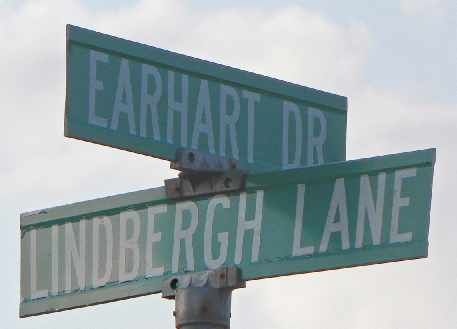
street signs in the neighborhood bearing the names of famous pilots.
Michael Bond reported in 2012, “I have the last wind sock that was flown there.”

A 9/28/13 aerial view showed no trace remaining of Flanders Valey Airport.
The site of Flanders Valley Airport is located on the north side of Reger Road,
across the road from the Flanders Valley Golf Course.
Thanks to James G. for pointing out this airfield.
____________________________________________________
Aircraft Radio Corporation Airfield, Boonton, NJ
40.935, -74.428 (West of New York, NY)

The Aircraft Radio Corporation Field,
as depicted on a 1929 ARC booklet entitled “Development of Aircraft Radio Receivers” (courtesy of Albert Helfrick).
According to Albert Helfrick (who “worked for ARC from 1977-84”),
a 1929 ARC booklet entitled “Development of Aircraft Radio Receivers”
stated “In the fall of 1927 the Aircraft Division of the Laboratories [Radio Frequency Laboratories Inc.]
was formed to handle the aircraft radio developments then in progress.”
Shortly after their incorporation, a "Flying Field" was established at their facility.
According to Albert Helfrick, the 1929 booklet “shows pictures of a totally complete facility:
buildings completely furnished, hangar, cleared runways etc.
It had to take more than a year to do this, especially with the North Jersey winters.
Also, the land is reasonably flat but there was a brook that ran through the property
and some of the land had to be filled in & graded. This had to take months.
Therefore, I would say the construction took place the entire year of 1928.”
Albert continued, “The booklet also shows a detailed plat of the property.
It shows the northwest/southeast runway at 2,200’ & northeast/southwest runway at 2,100’.”
In early 1929 a great engineering conference was held at the Flying Field,
and the electronic instruments industry came in full force to celebrate the opening & dedication
of the company's new facilities, which included a hangar at the Flying Field & a laboratory in the town of Boonton.
While his Consolidated trainer plane was hangared at ARC,
young Jimmy Doolittle became a familiar personality on the local scene.
It was in this plane in late 1929 that he made his famous "under-the-hood" landing at Mitchel Field, NY,
ARC personnel having installed his special ARC receiver & radio gear.

The 1930 "Rand McNally Standard Map of New Jersey With Air Trails" (courtesy of Chris Kennedy)
described the Aircraft Radio Corporation Airport as consisting of an irregularly shaped field,
measuring 2,200' northwest/southeast x 2,100' northeast/southwest.

A circa early 1930s aerial view depicted the Aircraft Radio Corporation Field
as an irregularly-shaped grass field, with a few small hangars on the west side of the property.
Note the airport circle marking in the center of the field.
By 1933, ARC-designed equipment was installed in the 1st fighter squadrons of the Army Air Corps & Navy.
The 1934 Department of Commerce Airport Directory (according to Chris Kennedy)
described the Aircraft Radio Corporation Airport as having two 2,200' sod runways oriented at right angles.

The earliest aeronautical chart depiction which has been located of the Aircraft Radio Corporation Airfield
was on the 1934 Sectional Aeronautical Chart.
The Airport Directory Company's 1937 Airports Directory (courtesy of Bob Rambo)
described the Aircraft Radio Corporation Field as having three 2,200' sod runways.

A 4/11/43 aerial view looking north from the 1945 AAF Airfield Directory (courtesy of Scott Murdock)
depicted the Aircraft Radio Corporation Airport as having several grass runways.
The directory described Aircraft Radio Corporation Airpoort as an 80 acre irregularly-shaped property
having 3 sod runways, the longest being a 2,200' northeast/southwest & northwest/southeast strips.
The field was said to have a single 60' x 50' concrete hangar,
to be owned by private interests, but not to be in operation (most likely due to wartime restrictions on general aviation near the coasts).

The 1947 USGS topo map depicted the “Aircraft Radio Corporation Airport” as an open field with several buildings along the west side.
According to former ARC employee Albert Helfrick, “As for the purchase date of ARC by Cessna,
I was told many years ago it became a 'wholly owned subsidiary' in 1954.
Later it became a 'division' of Cessna.
I have an article from 'The Citizen of Morris County', a magazine,
which outlines 'Boonton New Jersey, and its role in the Electronic Precision Instruments Industry', by Edgar Weed.
In the article it names the officers of ARC & they are the original RFL group,
so Cessna was not the owner or major player in 1950 giving credence to the 1954 date.”
The ARC company eventually went on to become the standard-equipment supplier of avionics
in the many thousands of Cessna civil aircraft produced between the 1950s & the 1980s.
They continued to use their airfield for test flights of aircraft equipped with their avionics.

A 1956 aerial photo looking northeast from a card commissioned by ARC (courtesy of Geroge Torpey).
George noted, “The buildings at the bottom housed the production facilities.
The engineering building is above it & the administrative functions were housed in the buildings above engineering.
The hangar is on the left of the runway about half way up the picture.”
George Torpey recalled, “I worked for Aircraft Radio from 1957 through 1970
holding a number of different positions in commercial field engineering & sales, systems engineering, and military sales & marketing,
all of which included piloting company owned and/or operated aircraft into & out of the Booton, NJ airfield.
It was a great place to work with a great history in the development of products for both military & commercial aviation.
It is sad that the company is probably remembered most for the lower-quality panel-mounted radios
that Cessna forced the company to build for their general aviation aircraft after they acquired ARC.”
The Aircraft Radio Corporation airfield was described in the 1962 AOPA Airport Directory
as having 3 grass runways with the longest being 3,100'.
However, former ARC employee Albert Helfrick disagreed: “The 1962 AOPA Airport Directory
suggestion that there were 3 runways can’t be right.
I have no idea where the 3rd runway would have been.
It is true that the northwest/southeast runway was extended to 3,100’.”
Mark Rusin recalled, “I grew up in Booton Township & from 1963-73, I lived almost directly across the street on Rockaway Valley Road.
From our kitchen window you could see the Cessna planes making their final approach for landing. I was always amazed.
On weekends you could watch the gliders take off & land there.
My sister had a horse & we would ride along the runway or run our lawn tractors along the edge of the runway.
When we walked home from School (Rockaway Valley School) we walked through the cemetery on Rockaway Road,
through Marotta's property, down the runway, and back home. We had some great times.
They had a dump on the property & they dumped electronic parts and wires (most likely illegal now)
and we would rummage through the dump looking for things we could play with, until someone chased us off.
I knew some kids back then that somehow got hold of a key to the hangar door
and on weekends when the pilots would leave their cars in the hangar & fly off to Florida or other spots,
the kids would go in the hangar & take the cars out for joy rides.
I can assure you I did not partake, but it happened a lot.”
Forrest Smith recalled, “My mother & Uncle used to work there.
They said it employed 3,500 people at one time before its demise.
The hangar was the only one on the field; it was used to install & test radios.”
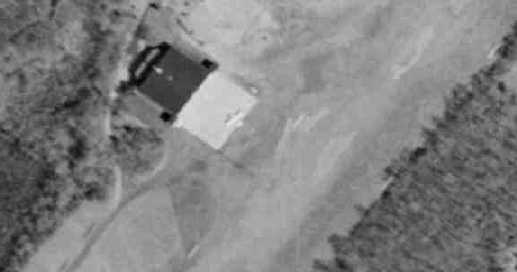
A closeup from a 1963 aerial photo depicted one single-engine aircraft in front of the hangar at Aircraft Radio.

An undated aerial view looking west at the ARC Airfield from a 1966 issue of the Cessna Pennant (courtesy of William Goebel),
showing a single light aircraft on the grass field,
with grass runways outlined with white markings.
Ron Estler recalled, “My father, LeRoy Estler worked at Aircraft Radio Corporation (ARC) for most his adult life, up to 1972. We lived fairly close by.
I remember when ARC would open its doors once a year to family – I have vivid recollections I walking through the facility with my father –
he worked for many years in the final test area.
In the fall of 1968, somehow my father got me on a test flight back to the Pennsylvania college I was attending – probably broke every rule there was – but it saved me a lot of time.
The Cessna was pretty well stripped-out & had lots of test equipment installed – it was a great flight!”
David Schober recalled, “I worked at ARC from January 1972 to August 1973, and again from May 1974 to April 1976.
The large building that was added on the northwest, closing the short cross runway was sometime in the 1973-74 time frame.
I know this because when I went back to work there in 1974, part of my department was moved 'upstairs'.
I worked in the Printed Circuit department & the plating shop was in the downstairs of the old building.
I was also a member of the flying club & in 1974, the 172 was only $10 / hour.”
John Biggers recalled, “I worked at ARC... from September of 1976 as an Avionics Flight Test Pilot / Engineer.”
Former ARC employee Albert Helfrick recalled, “The northeast/southwest runway apparently had not been used
for quite some time when I arrived in 1977 but it would appear on some maps.
It was a parking lot when I arrived.”

A December 1978 photo by Doug Crook of one of the Cessna Flying Club's 172s at the Aircraft Radio Company Airfield.
Doug recalled, “Here is one of the club's planes, N1571E preflighted & ready to go.
The airplane is parked to the left of the hangar;
it was always great going up on a weekend; just drive up, unlock the gate & let yourself in.
On a cold, clear day like this one, you always had great engine performance.
I learned to fly there in the 1970s. It was a special place.
I worked maintenance & cut the lawns for 3 summers while in college,
but all employees could join the Cessna flying club,
where we had new model year airplanes each year.
A 172 was $15/hour wet, a 152 was $7/hour wet!”

The Aircraft Radio Corporation airfield was still depicted
as an active (private) airfield on the 1979 NY TCA chart (courtesy of Bill Suffa).
It was shown as having a 3,100' unpaved runway.
The Aircraft Radio Corporation was eventually purchased by Cessna at an unknown date.
Cessna sold ARC & the airfield in the mid 1980s,
at which point the airfield became basically inactive.
The "Aircraft Radio Corp" airfield was depicted on the 1969 USGS topo map,
but was simply labeled "Airport" on subsequent USGS topo maps.

An October 1980 photo by Doug Crook, looking northwest along the crosswind runway,
with the hangar along the right side.
A twin-engine plane & a high-wing single-engine plane are visible in front of the hangar.
A 1981 New York Sectional chart still depicted it as an active private field.
According to former ARC employee Albert Helfrick,
it was about 1982 when a large new building was constructed adjacent to the west side of the northeast/southwest runway.”
Mathew Grubel recalled, “Aircraft Radio Corp. Field... I worked there from 1987-89 when Breed Corp / Breed Automotive used most of the facility.
The land was held under a different corporate name, something like Rockaway Valley Holding Corp.
It was no secret the runway was maintained.
One of our Vice Presidents kept his plane (a Cherokee) in the main hangar starting around 1988.
Also the tenant of Building #1 occasionally had his twin-engine Beechcraft on site.
He lives on top of one of the nearby hills (or did) & seemed to have some interest in aviation history.
On one of the anniversary dates of the first blind flight, there was a bunch of historic aircraft that flew in for a show.
It was open to the public.
Oh yes, the airstrips lights worked.
A couple times we got flights to take our products to test facilities, and at least one time we got back after sunset.”
The last photo which has been located showing an aircraft on the Aircraft Radio Airfield was a 1987 aerial view,
in which one single-engine aircraft was visible next to the hangar.

The 1990 USGS topo map depicted the ARC “Airport” as having 2 runways (the largest was 3,100' long) & a large hangar.
Steve Pavlisko recalled, "When I started flying in 1995, it was still pretty much an airstrip.
I remember seeing VASI lights out there on the end of the field as well.
It was on the aeronautical charts till 1995 I believe, and was indicated as a private airstrip."
The Aircraft Radio Corporation airfield apparently closed at some point between 1995-98,
as it was no longer depicted at all (even as an abandoned airfield) on the 1998 Sectional Chart.
The town government recently made arrangements
to take over the property from the previous owner to preserve as open space.
There is a historical marker along Rockaway Valley Road,
adjacent to a firehouse near the northern end of the main runway,
commemorating the use of the airfield by Billy Mitchell.
Aaron Gould reported in 2003 that "the airfield now has several obstacles in the form of soccer & lacrosse nets.
I recently flew over the field & found there to be significant radio controlled aircraft activity.
The obstacles on the field would probably preclude any emergency landing."
Aaron Gould reported in 2004 that "The Township of Boonton is stonewalling me as to who currently owns the main runway.
They say there is some sort of dispute as to whether they own it or the former owner owns it.
I asked them why then could they put lacrosse & soccer nets up on it if they didn't know if it was their property.
I received no reply.
If it does turn out that this property is owned by the former owner my father & I will be attempting to purchase the runway (3,100')
from them and we'll see where we can go from there. Keep your fingers crossed."

A 2005 photo by Forrest Smith of the front of the hangar at the Aircraft Radio Corporation Field.
Forrest observed, “The hangar is still in very good condition!
There are no planes inside, only small boats.”

A 2005 photo by Forrest Smith of the top of the hangar,
along which can still be discerned the lettering, “Aircraft Radio Corporation, Boonton, New Jersey”.

A 2005 photo by Forrest Smith looking north across the former runway at the hangar.
Forrest noted “The crosswind runway still has the metal wind direction indicator on it.”

A 2005 photo by Forrest Smith of one of the former Aircraft Radio Corporation production buildings.
According to Forrest, “Only a small portion of the old production buildings are now being used.”
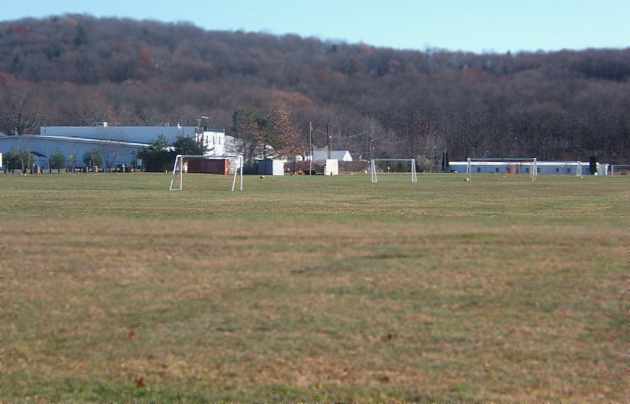
A 2005 photo by Forrest Smith, looking across the former runway
toward the former Aircraft Radio Corporation production buildings.
Forrest observed, “The field itself is still very neatly cut, but, has soccer nets on it.”

A 2005 photo by Forrest Smith of the historical plaque which commemorates the 1st instrument flight,
performed by Jimmy Doolittle in 1929 using radio equipment developed by the Aircraft Radio Corporation.
Terry Davis recalled, “Over the past several years, I've visited Aircraft Radio Corporation Airport twice.
The first time was between 2003-2007. I was driving by, and saw hangars, so I stopped to see.
I saw the large plaque commemorating Gen. Doolittle's first instrument flight. Wow. To be standing in the very place where that flight happened.”

A circa 2006 aerial view looking west at the hangar which remains at the Aircraft Radio airfield.
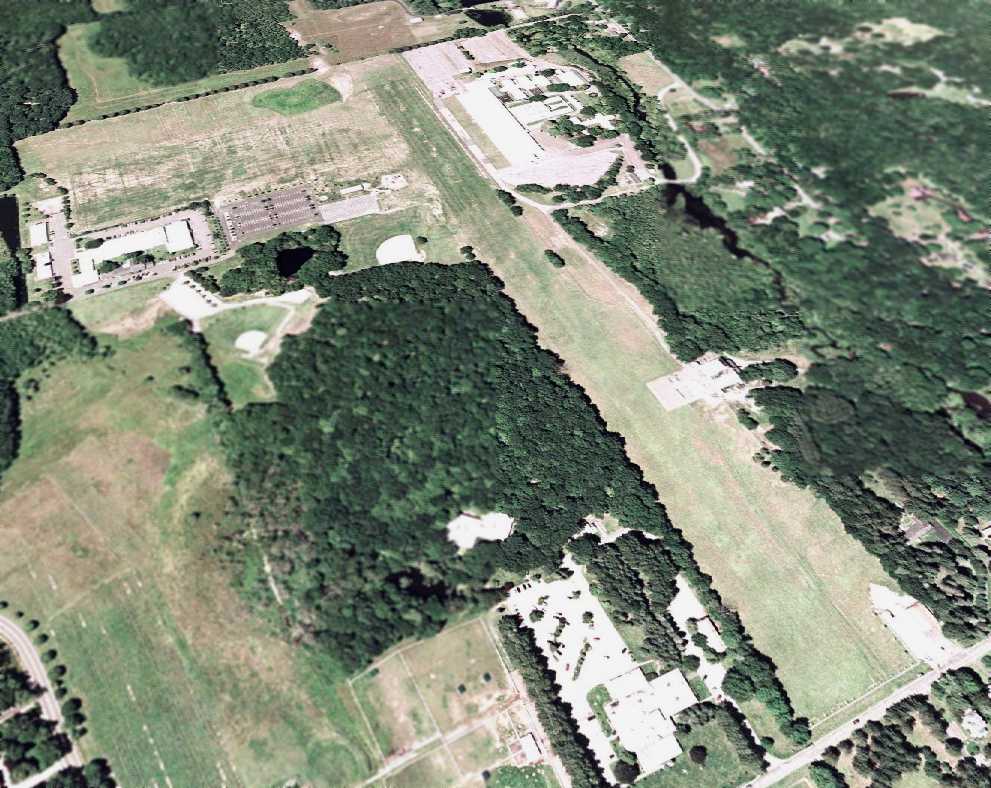
A July 4, 2007 aerial view looking southwest showed that the main runway still survives in excellent shape.
It is still cut to active-runway standards, and seems ready for use.
There appear to be some kind of lighting fixtures along the runway,
although lighting was not mentioned in its entry in the 1962 AOPA Airport Directory.
A model-airplane club uses the field on occasion for their activities.
The shorter crosswind runway (southeast corner) is being used for youth athletic fields.
The hangar has been well-maintained over the years, and still stands just east of the runway intersection.
Terry Davis recalled, “I A few years later [post-2007], I went there again, and the plaque [commemorating Doolittle's historic flight at ARC] had been removed.
A search of the grounds produce nothing. What a shame.”

A September 2011 photo of a windsock-shaped metal sign for the Doolittle's Landing playground near the site of the ARC airfield.
The Aircraft Radio Corporation field is located east of the intersection of Valley Road & Rockaway Valley Road.
Thanks to Aaron Gould for pointing out this airfield,
and to James G. for providing further historical background.
See also: http://www.boontontownship.com/about.htm
____________________________________________________
Since this site was first put on the web in 1999, its popularity has grown tremendously.
That has caused it to often exceed bandwidth limitations
set by the company which I pay to host it on the web.
If the total quantity of material on this site is to continue to grow,
it will require ever-increasing funding to pay its expenses.
Therefore, I request financial contributions from site visitors,
to help defray the increasing costs of the site
and ensure that it continues to be available & to grow.
What would you pay for a good aviation magazine, or a good aviation book?
Please consider a donation of an equivalent amount, at the least.
This site is not supported by commercial advertising –
it is purely supported by donations.
If you enjoy the site, and would like to make a financial contribution,
you
may use a credit card via
![]() ,
using one of 2 methods:
,
using one of 2 methods:
To make a one-time donation of an amount of your choice:
Or you can sign up for a $10 monthly subscription to help support the site on an ongoing basis:
Or if you prefer to contact me directly concerning a contribution (for a mailing address to send a check),
please contact me at: paulandterryfreeman@gmail.com
If you enjoy this web site, please support it with a financial contribution.
please contact me at: paulandterryfreeman@gmail.com
If you enjoy this web site, please support it with a financial contribution.
____________________________________________________
This site covers airfields in all 50 states.